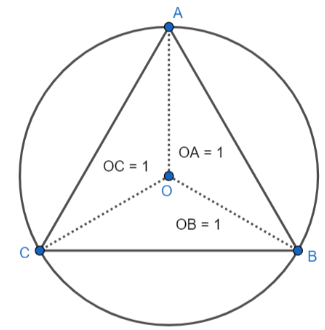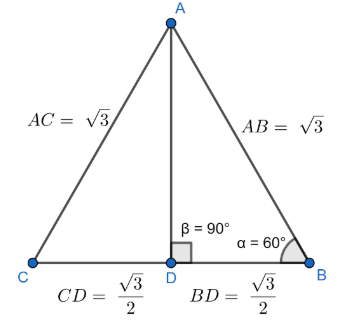
Find the area of an equilateral triangle inscribed in a circle of unit radius.
(a) $\dfrac{3}{4}$
(b) $\dfrac{3\sqrt{3}}{4}$
(c) $3$
(d) $\dfrac{3\sqrt{3}}{2}$
Answer
594.6k+ views
Hint: For solving this question we will use the formula of the Sine Rule $\dfrac{a}{\sin A}=\dfrac{b}{\sin B}=\dfrac{c}{\sin C}=2R$ . After that, we will find the length of each side of the given equilateral triangle. Then, we will draw the figure of the given equilateral triangle and try to find the length of the height of the triangle by applying some basic concepts of trigonometry like $\sin \theta =\dfrac{\text{length of the perpendicular}}{\text{length of the hypotenuse}}$ . After that, we will find the value of the area by applying the formula $\dfrac{1}{2}\times \left( base \right)\times \left( height \right)$ correctly.
Complete step-by-step solution -
Given:
We have to find the area of the equilateral triangle inscribed in a circle of unit radius.
For more clarity look at the figure given below:

In the above figure, $R$ is the radius of the circumcircle and $r$ is the radius of the incircle of the $\Delta ABC$ , where $BC=a$ , $AC=b$ , $AB=c$ , $\angle ABC=\angle B$ , $\angle BAC=\angle A$ and $\angle ACB=\angle C$ . Then,
$OA=OB=OC=R=1..............\left( 1 \right)$
Now, before we proceed we should know the following formulas:
$\dfrac{a}{\sin A}=\dfrac{b}{\sin B}=\dfrac{c}{\sin C}=2R\text{ }\left( \text{Sine Rule} \right)$
Now, as it is given that, $\Delta ABC$ is an equilateral triangle. And, as we know that in an equilateral triangle all sides are of equal length and all internal angles are of ${{60}^{0}}$ . Then,
$\begin{align}
& a=b=c \\
& A=B=C={{60}^{0}} \\
\end{align}$
Now, we put $R=1$ from equation (1) and $a=b=c\text{ , }A=B=C={{60}^{0}}$ from the above equation in the result of “Sine Rule”. Then,
$\begin{align}
& \dfrac{a}{\sin A}=\dfrac{b}{\sin B}=\dfrac{c}{\sin C}=2R\text{ }\left( \text{Sine Rule} \right) \\
& \Rightarrow \dfrac{a}{\sin \left( {{60}^{0}} \right)}=\dfrac{b}{\sin \left( {{60}^{0}} \right)}=\dfrac{c}{\sin \left( {{60}^{0}} \right)}=2 \\
& \Rightarrow a=b=c=2\sin \left( {{60}^{0}} \right) \\
\end{align}$
Now, we put $\sin \left( {{60}^{0}} \right)=\dfrac{\sqrt{3}}{2}$ in the above equation. Then,
$\begin{align}
& a=b=c=2\sin \left( {{60}^{0}} \right) \\
& \Rightarrow a=b=c=2\times \dfrac{\sqrt{3}}{2} \\
& \Rightarrow a=b=c=\sqrt{3} \\
\end{align}$
Now, from the above result, we conclude that the length of each side of the given equilateral triangle is $\sqrt{3}$ units.
Now, we draw segment AD perpendicular from the vertex A to the side BC and as it is an equilateral triangle AD will bisect the side BC. Moreover, as it is an equilateral triangle, the value of $\angle ABC=\angle BAC=\angle BCA={{60}^{0}}$ . For more clarity look at the figure given below:

In the above figure, as AD bisects BC so, the length of BD will be equal to $\dfrac{\sqrt{3}}{2}$ .
Now, consider $\Delta ABD$ we have $AB=\sqrt{3},BD=\dfrac{\sqrt{3}}{2}$ and $\angle ABD={{60}^{0}},\angle ADB={{90}^{0}}$ . Then,
$\begin{align}
& \sin \left( \angle ABD \right)=\dfrac{\left( \text{length of the perpendicular AD} \right)}{\left( \text{length of the hypotenuse BA} \right)} \\
& \Rightarrow \sin {{60}^{0}}=\dfrac{AD}{BA} \\
& \Rightarrow AD=BA\times \dfrac{\sqrt{3}}{2} \\
& \Rightarrow AD=\sqrt{3}\times \dfrac{\sqrt{3}}{2} \\
& \Rightarrow AD=\dfrac{3}{2} \\
\end{align}$
Now, in the equilateral triangle ABC we have the length of the base BC equal to $\sqrt{3}$ and length of the height AD is equal to $\dfrac{3}{2}$ . Then,
$\begin{align}
& Area=\dfrac{1}{2}\times \left( base \right)\times \left( height \right) \\
& \Rightarrow Area=\dfrac{1}{2}\times \sqrt{3}\times \dfrac{3}{2} \\
& \Rightarrow Area=\dfrac{3\sqrt{3}}{4} \\
\end{align}$
Now, from the above result, we conclude that the value of the area of the given equilateral triangle will be $\dfrac{3\sqrt{3}}{4}\text{ sq}\text{.unit}$ .
Hence, (b) will be the correct option.
Note: Here, the student should first understand the basic concepts of the equilateral triangle and sine rule then, apply the basic concept of trigonometry. After that, find the height of the triangle and then calculate the value of the area of the triangle by the conventional formula. Moreover, for objective problems, we could use directly formula $\dfrac{3\sqrt{3}}{4}{{R}^{2}}$ to find the area of an equilateral triangle of circumcircle radius $R$ units.
Complete step-by-step solution -
Given:
We have to find the area of the equilateral triangle inscribed in a circle of unit radius.
For more clarity look at the figure given below:

In the above figure, $R$ is the radius of the circumcircle and $r$ is the radius of the incircle of the $\Delta ABC$ , where $BC=a$ , $AC=b$ , $AB=c$ , $\angle ABC=\angle B$ , $\angle BAC=\angle A$ and $\angle ACB=\angle C$ . Then,
$OA=OB=OC=R=1..............\left( 1 \right)$
Now, before we proceed we should know the following formulas:
$\dfrac{a}{\sin A}=\dfrac{b}{\sin B}=\dfrac{c}{\sin C}=2R\text{ }\left( \text{Sine Rule} \right)$
Now, as it is given that, $\Delta ABC$ is an equilateral triangle. And, as we know that in an equilateral triangle all sides are of equal length and all internal angles are of ${{60}^{0}}$ . Then,
$\begin{align}
& a=b=c \\
& A=B=C={{60}^{0}} \\
\end{align}$
Now, we put $R=1$ from equation (1) and $a=b=c\text{ , }A=B=C={{60}^{0}}$ from the above equation in the result of “Sine Rule”. Then,
$\begin{align}
& \dfrac{a}{\sin A}=\dfrac{b}{\sin B}=\dfrac{c}{\sin C}=2R\text{ }\left( \text{Sine Rule} \right) \\
& \Rightarrow \dfrac{a}{\sin \left( {{60}^{0}} \right)}=\dfrac{b}{\sin \left( {{60}^{0}} \right)}=\dfrac{c}{\sin \left( {{60}^{0}} \right)}=2 \\
& \Rightarrow a=b=c=2\sin \left( {{60}^{0}} \right) \\
\end{align}$
Now, we put $\sin \left( {{60}^{0}} \right)=\dfrac{\sqrt{3}}{2}$ in the above equation. Then,
$\begin{align}
& a=b=c=2\sin \left( {{60}^{0}} \right) \\
& \Rightarrow a=b=c=2\times \dfrac{\sqrt{3}}{2} \\
& \Rightarrow a=b=c=\sqrt{3} \\
\end{align}$
Now, from the above result, we conclude that the length of each side of the given equilateral triangle is $\sqrt{3}$ units.
Now, we draw segment AD perpendicular from the vertex A to the side BC and as it is an equilateral triangle AD will bisect the side BC. Moreover, as it is an equilateral triangle, the value of $\angle ABC=\angle BAC=\angle BCA={{60}^{0}}$ . For more clarity look at the figure given below:

In the above figure, as AD bisects BC so, the length of BD will be equal to $\dfrac{\sqrt{3}}{2}$ .
Now, consider $\Delta ABD$ we have $AB=\sqrt{3},BD=\dfrac{\sqrt{3}}{2}$ and $\angle ABD={{60}^{0}},\angle ADB={{90}^{0}}$ . Then,
$\begin{align}
& \sin \left( \angle ABD \right)=\dfrac{\left( \text{length of the perpendicular AD} \right)}{\left( \text{length of the hypotenuse BA} \right)} \\
& \Rightarrow \sin {{60}^{0}}=\dfrac{AD}{BA} \\
& \Rightarrow AD=BA\times \dfrac{\sqrt{3}}{2} \\
& \Rightarrow AD=\sqrt{3}\times \dfrac{\sqrt{3}}{2} \\
& \Rightarrow AD=\dfrac{3}{2} \\
\end{align}$
Now, in the equilateral triangle ABC we have the length of the base BC equal to $\sqrt{3}$ and length of the height AD is equal to $\dfrac{3}{2}$ . Then,
$\begin{align}
& Area=\dfrac{1}{2}\times \left( base \right)\times \left( height \right) \\
& \Rightarrow Area=\dfrac{1}{2}\times \sqrt{3}\times \dfrac{3}{2} \\
& \Rightarrow Area=\dfrac{3\sqrt{3}}{4} \\
\end{align}$
Now, from the above result, we conclude that the value of the area of the given equilateral triangle will be $\dfrac{3\sqrt{3}}{4}\text{ sq}\text{.unit}$ .
Hence, (b) will be the correct option.
Note: Here, the student should first understand the basic concepts of the equilateral triangle and sine rule then, apply the basic concept of trigonometry. After that, find the height of the triangle and then calculate the value of the area of the triangle by the conventional formula. Moreover, for objective problems, we could use directly formula $\dfrac{3\sqrt{3}}{4}{{R}^{2}}$ to find the area of an equilateral triangle of circumcircle radius $R$ units.
Recently Updated Pages
Master Class 12 Business Studies: Engaging Questions & Answers for Success

Master Class 12 Economics: Engaging Questions & Answers for Success

Master Class 12 English: Engaging Questions & Answers for Success

Master Class 12 Maths: Engaging Questions & Answers for Success

Master Class 12 Social Science: Engaging Questions & Answers for Success

Master Class 12 Chemistry: Engaging Questions & Answers for Success

Trending doubts
Write a letter to the principal requesting him to grant class 10 english CBSE

Why is there a time difference of about 5 hours between class 10 social science CBSE

What is the median of the first 10 natural numbers class 10 maths CBSE

The Equation xxx + 2 is Satisfied when x is Equal to Class 10 Maths

Discuss the main reasons for poverty in India

10 examples of evaporation in daily life with explanations




